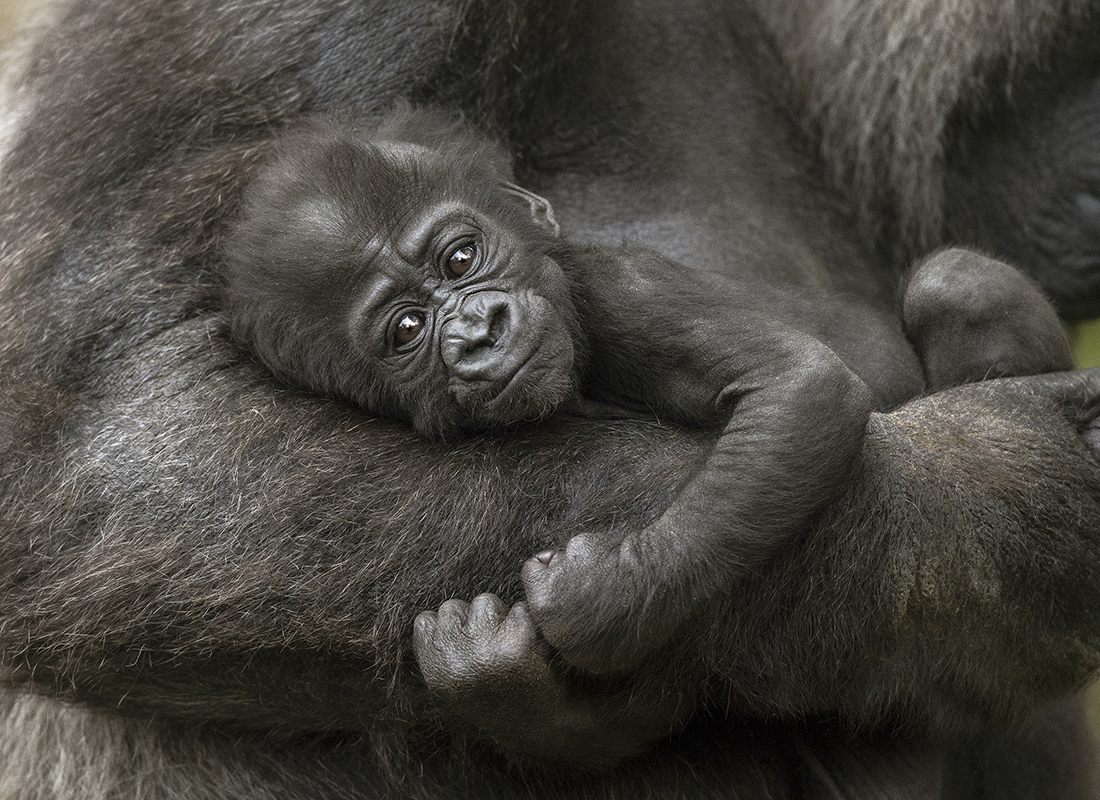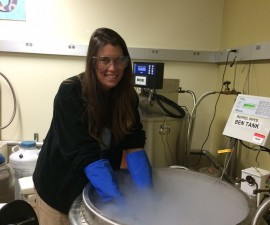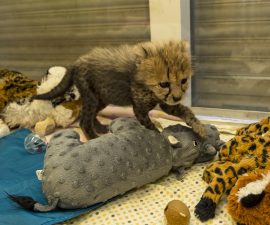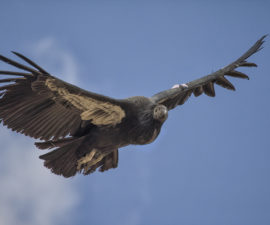Critically endangered and threatened species births at the Safari Park are generating excitement—and smiles.
BY Eston Ellis
Photography by Ken Bohn
The birth of any baby is a cause for celebration, but some of the San Diego Zoo Safari Park’s newest babies are especially welcome arrivals. These young animals represent critically endangered and threatened species, and their births signal new hope for the future.
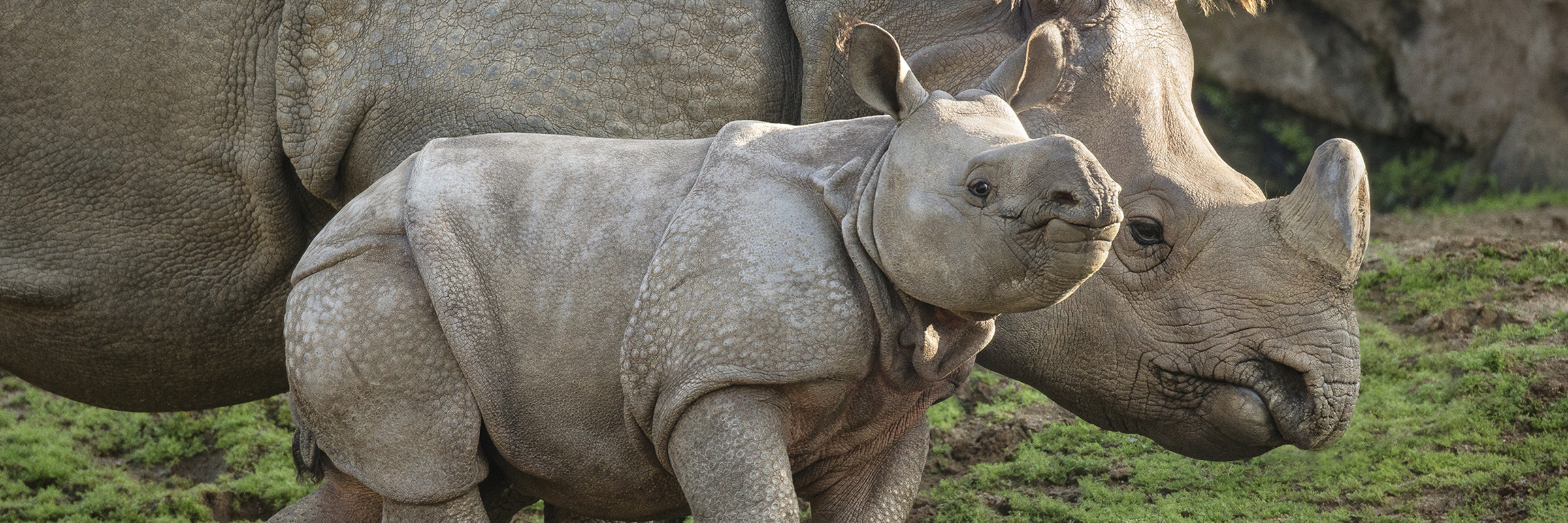
Armor and Awwws
Born November 10, 2016 to mother Tayana and father Bhopu, a playful greater one-horned rhino Rhinoceros unicornis named Taj started exploring his habitat in the Park’s Asian Plains on January 18. Taj means crown or jewel in Hindi, and this little rhino is definitely a rare treasure. Taj is the 70th greater one-horned rhino to be born at the Safari Park since 1972, and the Park’s breeding program for this species is the most successful in the world. There are only about 3,300 greater one-horned rhinos left in their native habitat, and they face the threat of poaching for their sought-after horn. However, the Indian government is doing a good job in its anti-poaching efforts, said Andy Blue, associate curator of mammals at the Safari Park.
MEET THE NEIGHBORS
On his first day in the 40-acre Asian Plains habitat at the Safari Park, baby Taj stuck close to his mom, but had fun playing in a mud wallow, exploring rocky terrain, and meeting a Malayan sambar deer. (Videography by Sharyn Umana-Angers)
At the Safari Park, newborn greater one-horned rhinos have the protection of a temperature-controlled boma, giving the mom and calf a secure place to bond. “With greater one-horned rhinos, we always bring them in about three weeks before they give birth,” Andy said. The keepers maintain a 24-hour watch, closely monitoring the birth and how the mother is nursing and caring for her new calf. “We can step in and hand raise if they aren’t nursing, or supplement feedings if they aren’t getting enough nutrition.” That wasn’t necessary with Taj. “Tayana has been a good mom,” Andy said. “She is also very protective.”
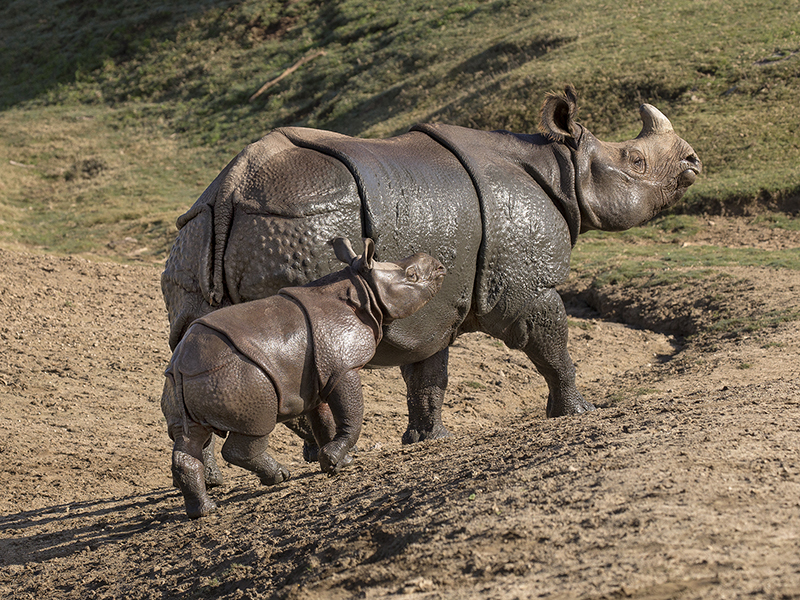
WALK THIS WAY
Taj’s mother, Tayana, is calm and confident—and her playful, inquisitive son is already exhibiting those same traits as he explores his surroundings under her watchful eyes.
Tayana gave Taj all the nutrition and care he needed. The fact that she is a calm, confident mom has made Taj a calm, confident calf, Andy said. Like other rhino calves, he is expected to stay with mom for about two years, until she is ready to give birth to another calf. Taj weighed around 180 pounds at birth, and he’s growing fast. “We try to get a weight at growth spurts, using a creep,” Andy said. The “creep” is an enclosure designed so that young rhinos enter and step on a scale, while protective rhino moms stay nearby outside, since the door is too small for them.
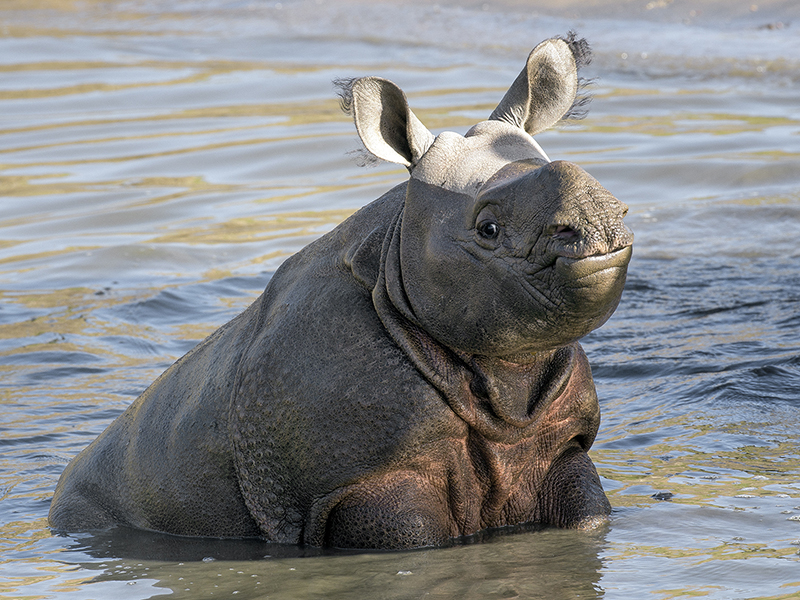
BATHING BABY
Young Taj has discovered the joys of getting wet—and getting covered with mud provides a layer of natural sunscreen to protect his sensitive skin.
On his first day in the 40-acre Asian Plains habitat, Taj played in a mud wallow, explored steep terrain with large boulders, and got a nose-to-nose view of other animals, including a Malayan sambar deer. He would later meet other rhinos, including his three-year-old sister Petunia. While Taj’s first moves in the field exhibit involved cautious exploration, Andy expects Taj will soon become much braver—and more mischievous. “We’ll be watching every activity,” Andy said. “He’s inquisitive with the keepers, and he’s a curious little guy. Soon, he will be playfully chasing anyone within reach, because he knows he has his mom backing him up. And that’s 6,000 pounds of backup!”
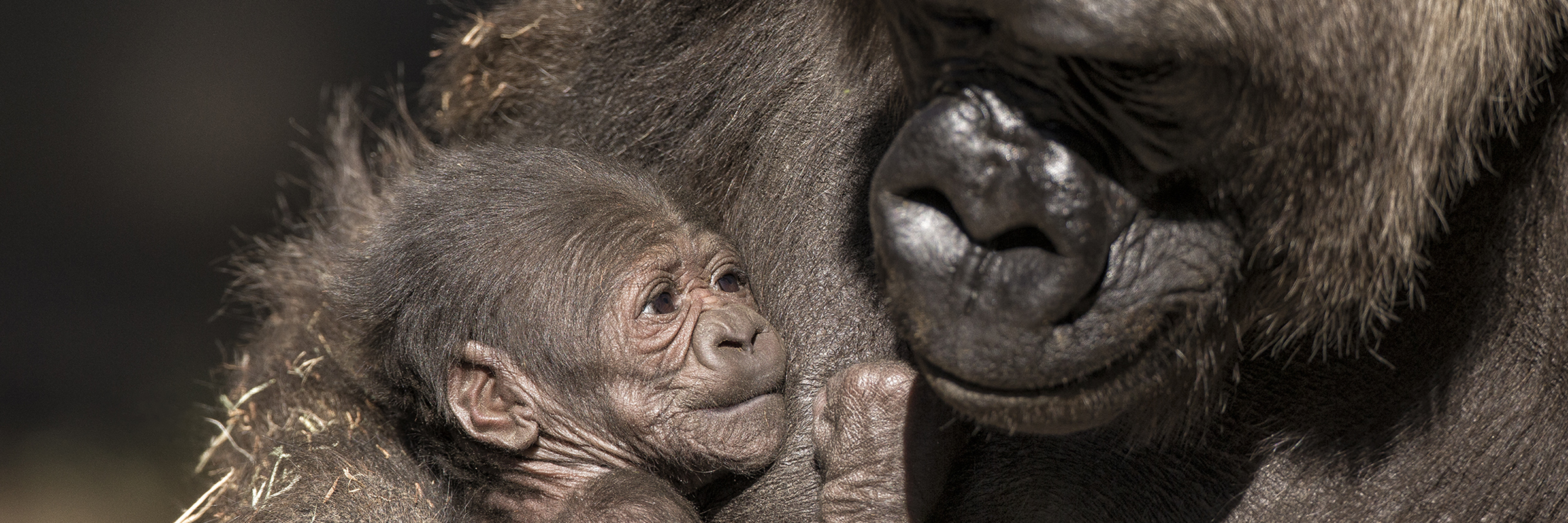
Girl-illa Power
At Gorilla Forest, the Safari Park’s western lowland gorilla Gorilla gorilla gorilla troop welcomed a new family member October 19, 2016: Leslie. Born to Kokamo, an experienced six-time mom, and troop leader silverback Winston, Leslie weighed about four pounds at birth. Keepers knew Kokamo was expecting, so they were excited when they arrived at the gorilla house that morning to find Kokamo with her newborn cradled in her arms.
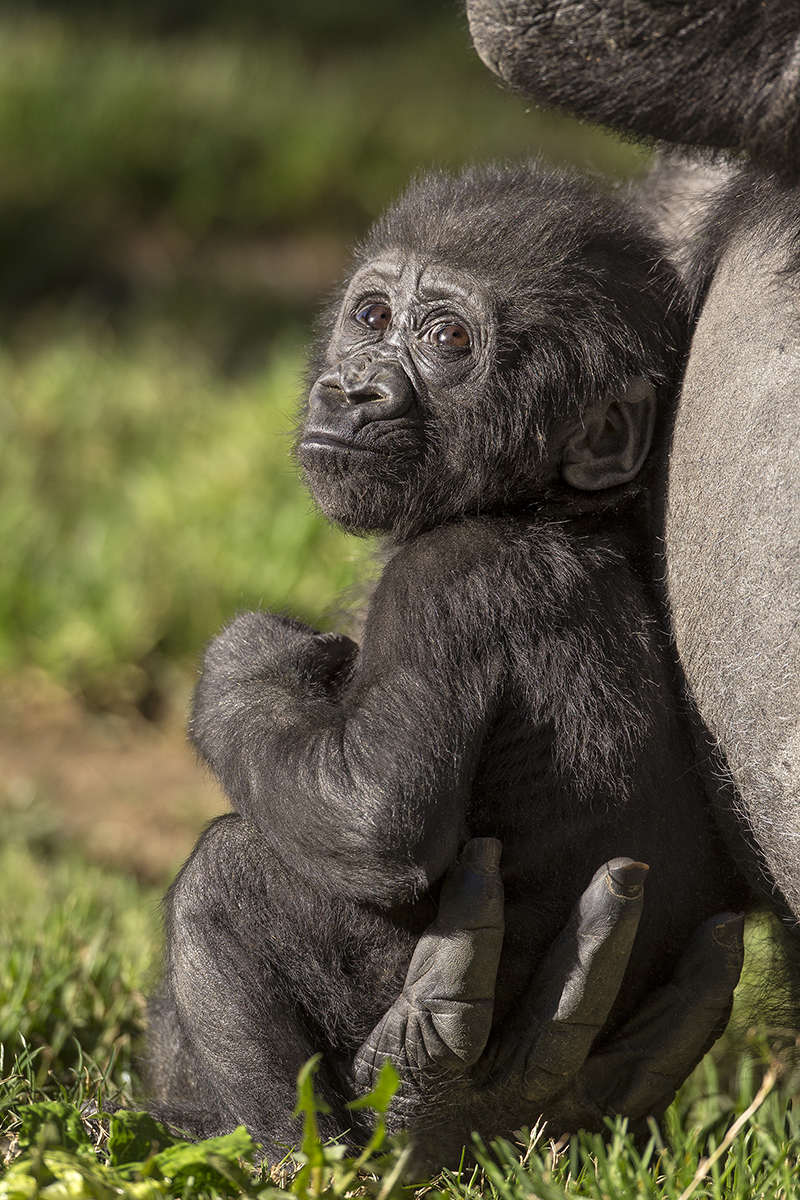
SHE’S A HANDFUL
Leslie stuck very close to her mom, Kokamo, during her first few months, but now she’s growing more curious about everything around her.
Kokamo’s five-year-old son, Monroe, moped a bit on Leslie’s first day, but he soon got over it and has become a doting big brother, said Peggy Sexton, lead keeper. Now, Kokamo will put baby Leslie in Monroe’s lap and let him hold her. “He’s very gentle with her,” Peggy said. “Everything is well supervised by mom. As her brother, he’s got first dibs on holding Leslie, before the rest of the troop gets that opportunity.” Kokamo has been observed putting baby Leslie on Monroe’s back, and letting her take a ride, Peggy said. “It’s common behavior for a gorilla mom to let her baby ride dorsally, but Kokamo didn’t let Monroe do that. It will be interesting to see if she eventually lets Leslie ride on her back.”
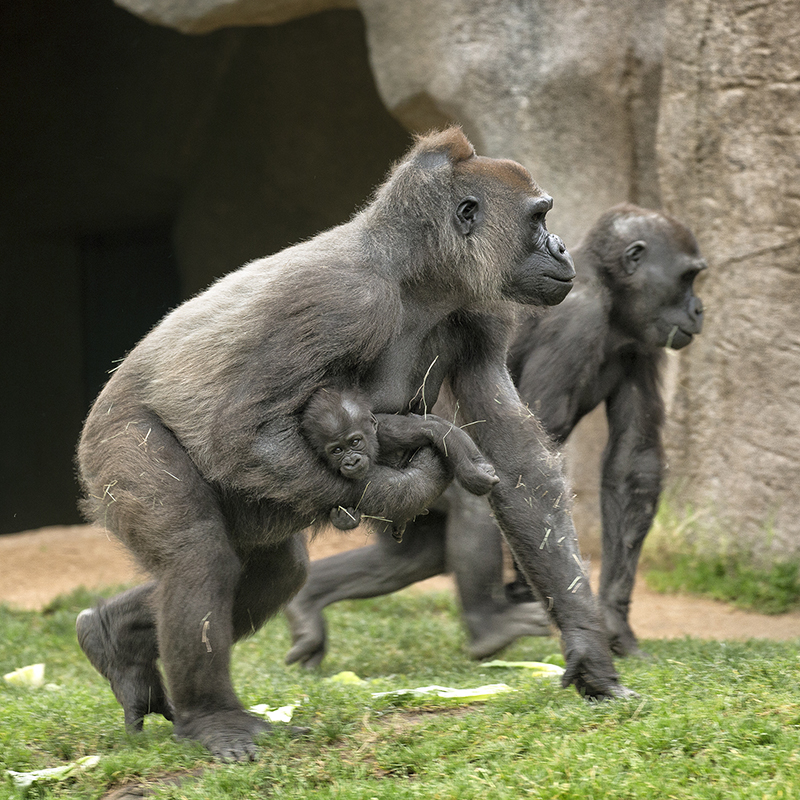
HAVE GIRL, WILL TRAVEL
Kokamo is an attentive mom, carrying Leslie with her wherever she goes—and sometimes letting Leslie take a ride on the back of her five-year-old brother, Monroe.
Like all growing babies, Leslie is getting her vaccinations. “Mom has been very cooperative with us in presenting her infant during training sessions for feeding and injections,” Peggy said. Leslie has been a healthy youngster, nursing regularly. She will continue to nurse for about three years, but she had six teeth at last count. She is sampling other foods and browse, including taking small bites of food from the keepers: banana, orange, and her favorite, cooked yams.
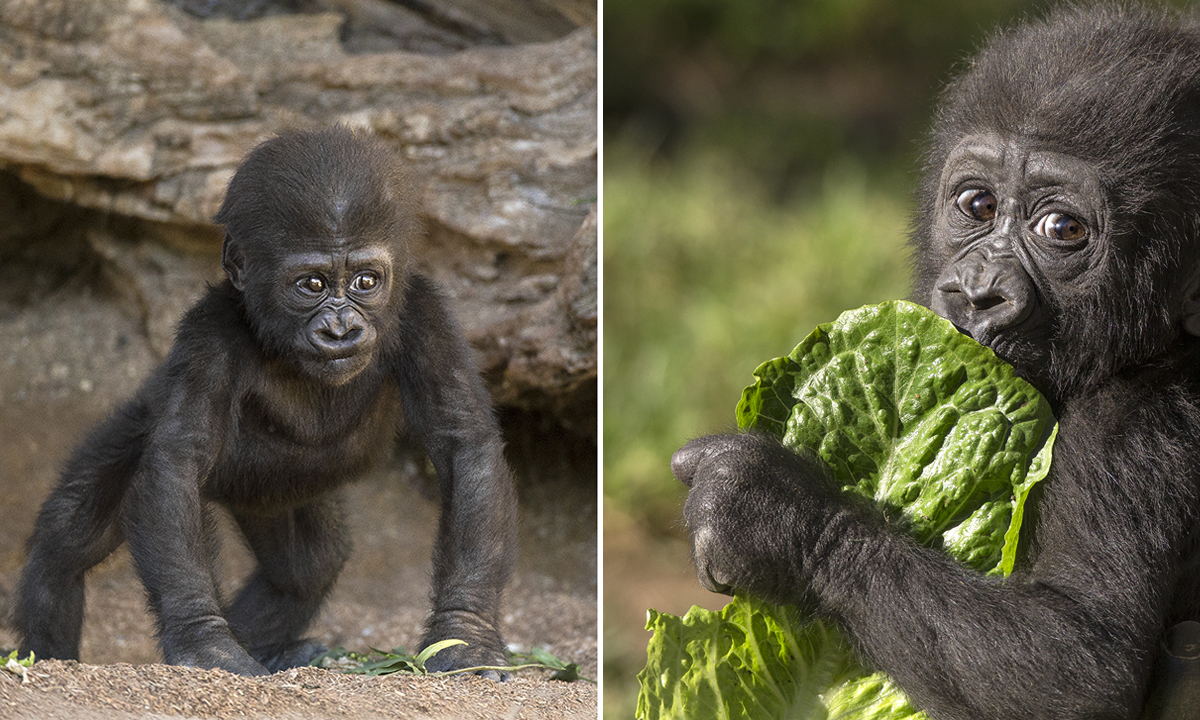
BABY STEPS
Leslie is growing quickly. She has already learned to crawl on her own, and she is sampling a variety of foods and browse to supplement her mother’s milk.
Leslie is also starting to be more mobile. “Mom is now putting her down on the ground and letting her crawl,” Peggy said. Guests at the Park may see Kokamo gently flip Leslie over onto her stomach, and then watch as Leslie starts to crawl and explore her surroundings. “Leslie is becoming more curious about what’s going on beyond mom. She seems to be growing and developing right on schedule,” Peggy said. “We look at things like vitality, bright eyes, and ability to hold on—initially, she was pretty much a barnacle. But as she’s growing, Leslie is escaping and exploring as much as she possibly can. If she gets too far, though, Kokamo pulls her right back.”
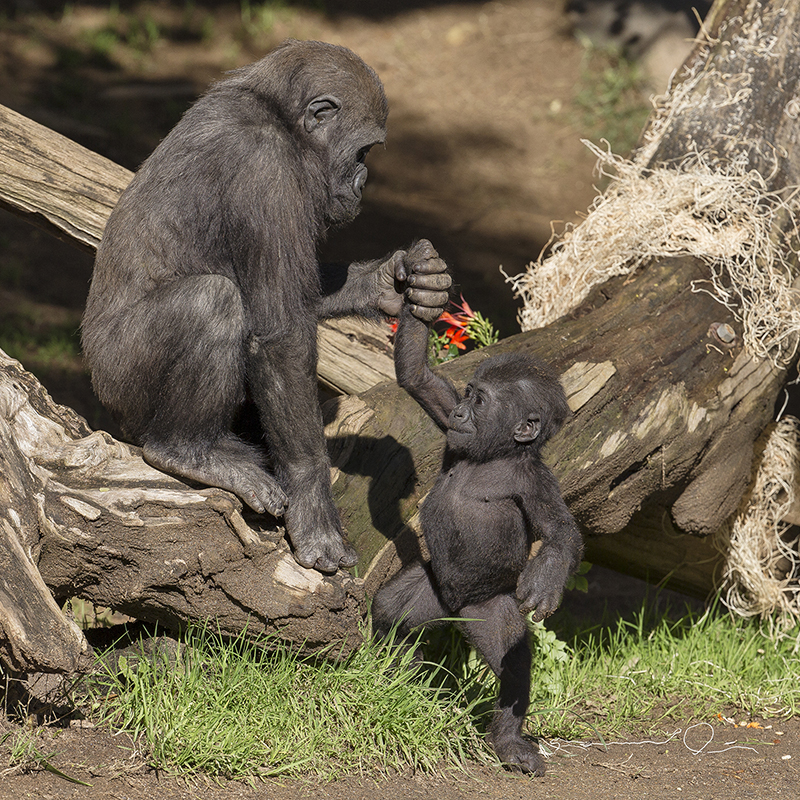
HELPING HAND
In addition to her mom’s tender care, Leslie is getting a lot of attention from her half-sister, Joanne. Their father is troop leader Winston.
Western lowland gorillas are listed as Critically Endangered on the IUCN Red List of Threatened Species, and their population numbers in the wild continue to decline. Leslie’s arrival is not only a boon to her troop at the Safari Park, but also good news for her species.
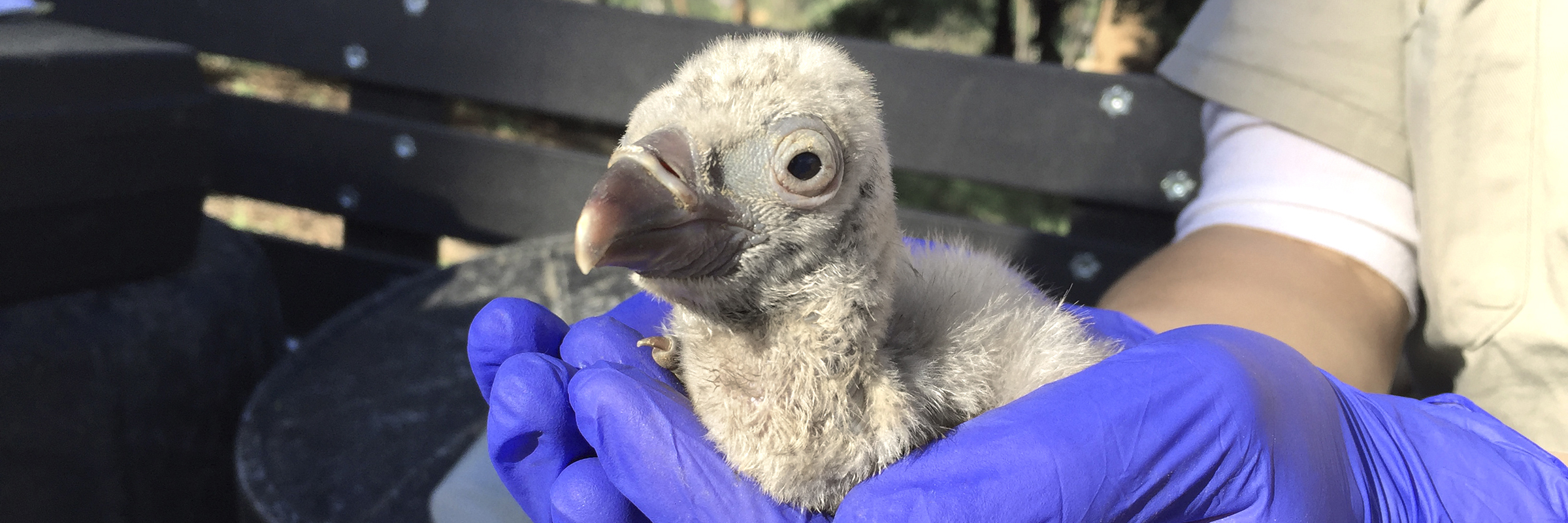
Chicky Baby
While not everyone expects a baby vulture to be cute and its parents to be adoring, the Safari Park’s Ruppell’s vulture Gyps rueppelli chick is loved by one and all. Critically endangered Ruppell’s vultures lay just one egg per year—and there’s a lot of responsibility riding on mom and dad. They take turns incubating that egg for about 56 days. After hatching, it takes another 150 days of devotion before the chick fledges.
It also takes a lot of care—from a respectable distance—from the keepers in the Safari Park’s Ruppell’s vulture breeding program. Both the vultures and the keepers are evidently doing all the right things: the Safari Park is currently the only breeding program in North America that is successfully raising Ruppell’s vulture chicks. It now has 12 Ruppell’s vultures, including 10 adults. “Our new chick is a male, which is good since we have more females than males right now,” explained Lauren Wright, senior keeper. “This is the 26th chick we’ve hatched since our breeding program started in 1996.” The species’ numbers in Africa are continuing to drop, due to both intentional and unintentional poisoning and habitat encroachment. Breeding programs are helping to create assurance populations of Ruppell’s vultures in zoos.
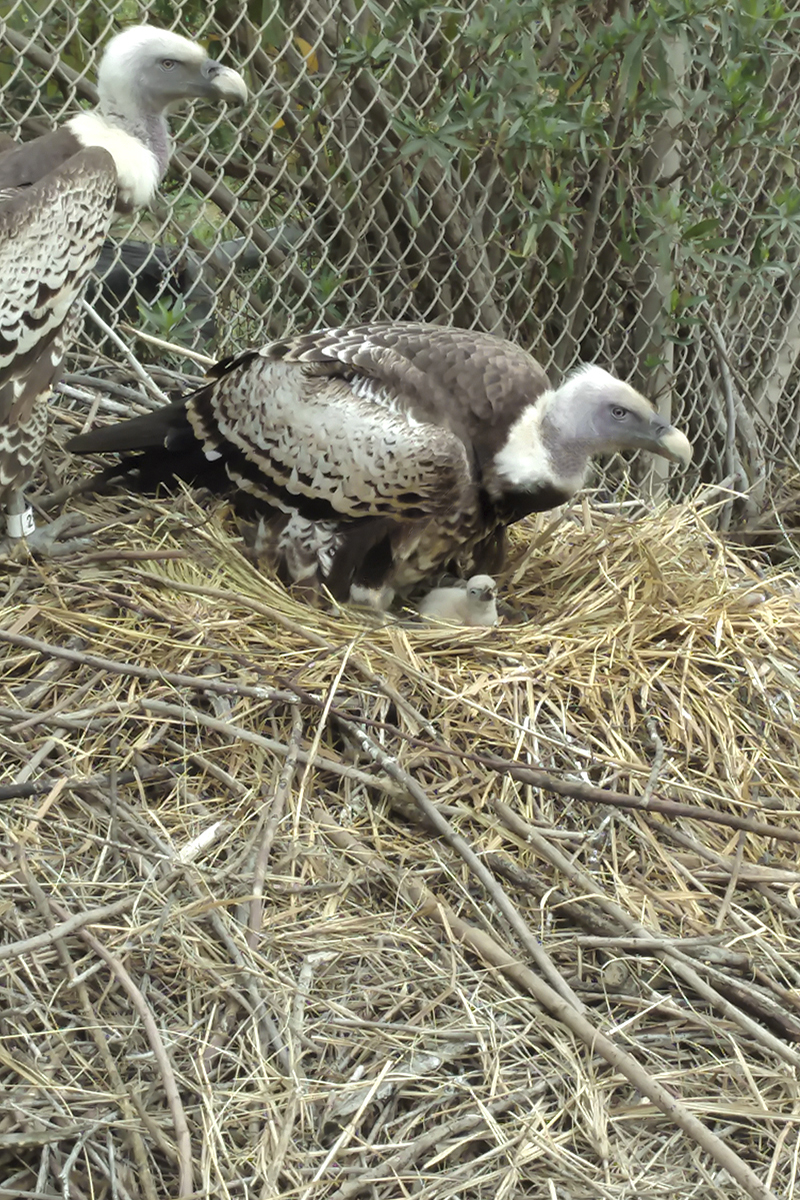
FAMILY AFFAIR
Both of the Ruppell’s vulture chick’s parents have been devoted to caring for their baby, keeping the nest dry despite heavy rains in January, and providing lots of food. That last responsibility is a big one, because the chick must eat enough to grow 45 times heavier in just 150 days.
When the Park’s vulture parents began building their nest, “we provided all kinds of different materials,” Lauren said. “This year, they really liked African grasses—lining the twigs at the base of the nest with soft stuff like dried grasses and papyrus tops and shaping it into a bowl. They also use plant trimmings and did some of the trimming themselves, clipping specific plants they wanted.”
Local ravens and crows may go after eggs in the vulture exhibit, so when the egg was laid on November 1, keepers replaced it with a dummy egg and took the real one to be incubated safely. When they heard the chick making sounds inside, indicating that it was almost ready to hatch, they returned it to the parents’ nest. “We jokingly call it a ‘talking egg’ at that point—but really it is called an ‘internal pip,’” Lauren said. “The parents start getting very aggressive as soon as it starts to hatch,” Lauren said. “We give them plenty of space.” The chick hatched on December 29.
At hatch, the chick weighs about 5.3 ounces and will grow to its full adult weight of about 15 pounds in just 150 days. “It’s crazy that the parents can provide all that food,” Lauren said. The crop of the adult Ruppell’s vulture can hold 3.3 pounds, which is about 20 percent of the adult bird’s weight. “They have a big capacity in their crop, so they can feed, and then go unload. In the first few days after the chick hatches, we support the parents,” Lauren said. “They are so concerned with the chick that they sometimes don’t want to eat. If all goes as planned, after those first days, they’re on their own.”
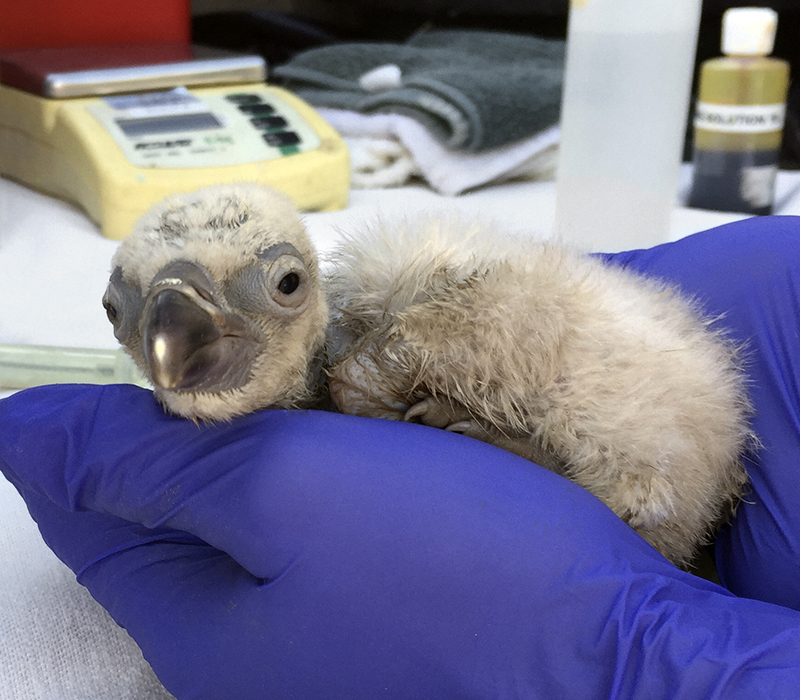
WEIGHING THE BABY
Keepers weighed and examined the new Ruppell’s vulture chick soon after it hatched last December, and then returned it to its very protective parents.
The parents have been very attentive to their new chick, especially through the heavy rains in January. “Dad’s been a pancake—spreading out, covering the chick with his body and getting soaking wet—but the chick stayed warm and dry,” Lauren said. If the vulture chick isn’t comfortable, he doesn’t keep it a secret. “The chick is super noisy if he gets any cold air,” Lauren said.
“The chick starts fledging by stepping off the nest,” Lauren said. “If he gets scared, he will run back, and the parents will probably still brood him. But when he goes off and feeds with the rest of the vultures, then the parents will no longer be taking care of him. He will stay in the exhibit with the rest of the flock.” Safari Park guests will then be able to see him in the exhibit from the Africa Tram, or on an African Cart Safari experience. “They do take a long time to mature—about five years—so it will be a while before this chick contributes to our breeding population,” Lauren said.
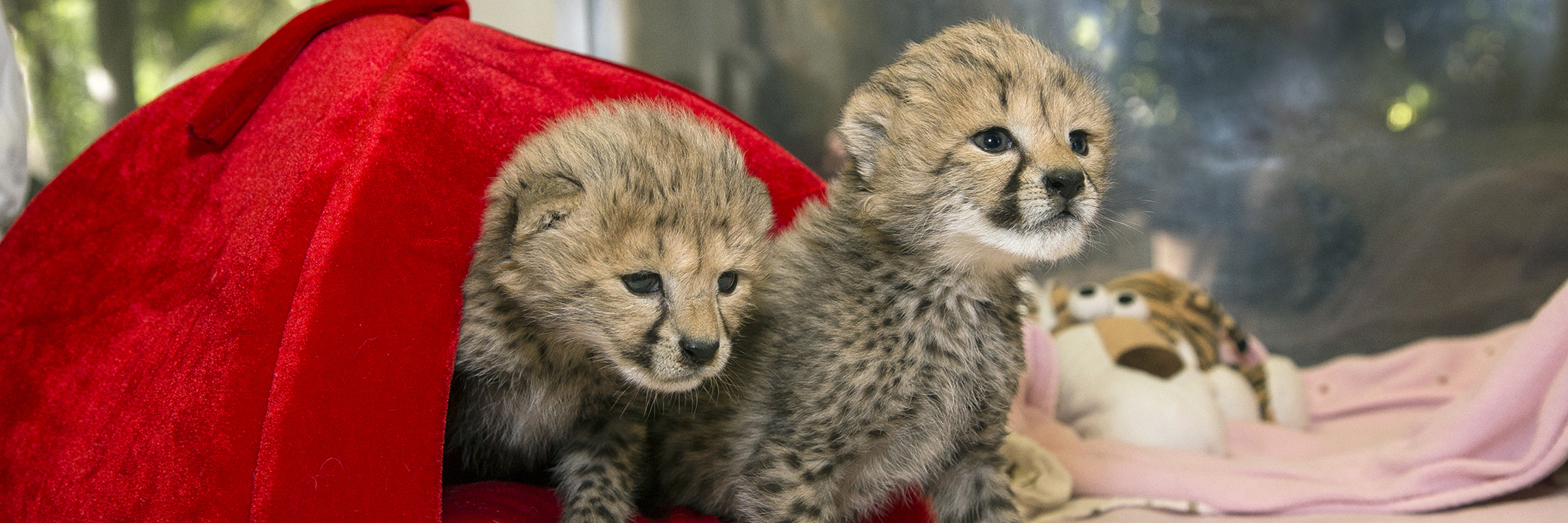
Pouncing Baby Girls
The Safari Park welcomed two fluffy, charismatic cubs last November 19, when cheetah Acinonyx jubatus mom Ally gave birth to sisters Tombi-Jeanne and Ilangha. Although Ally had raised cubs in the past, for unknown reasons, she walked away from this litter. So the two girls were hand raised at the Park’s Ione and Paul Harter Animal Care Center. “They required 24-hour-care for the first few weeks in the nursery,” explained Lissa McCaffree, lead keeper. “We started off feeding them every two hours.”
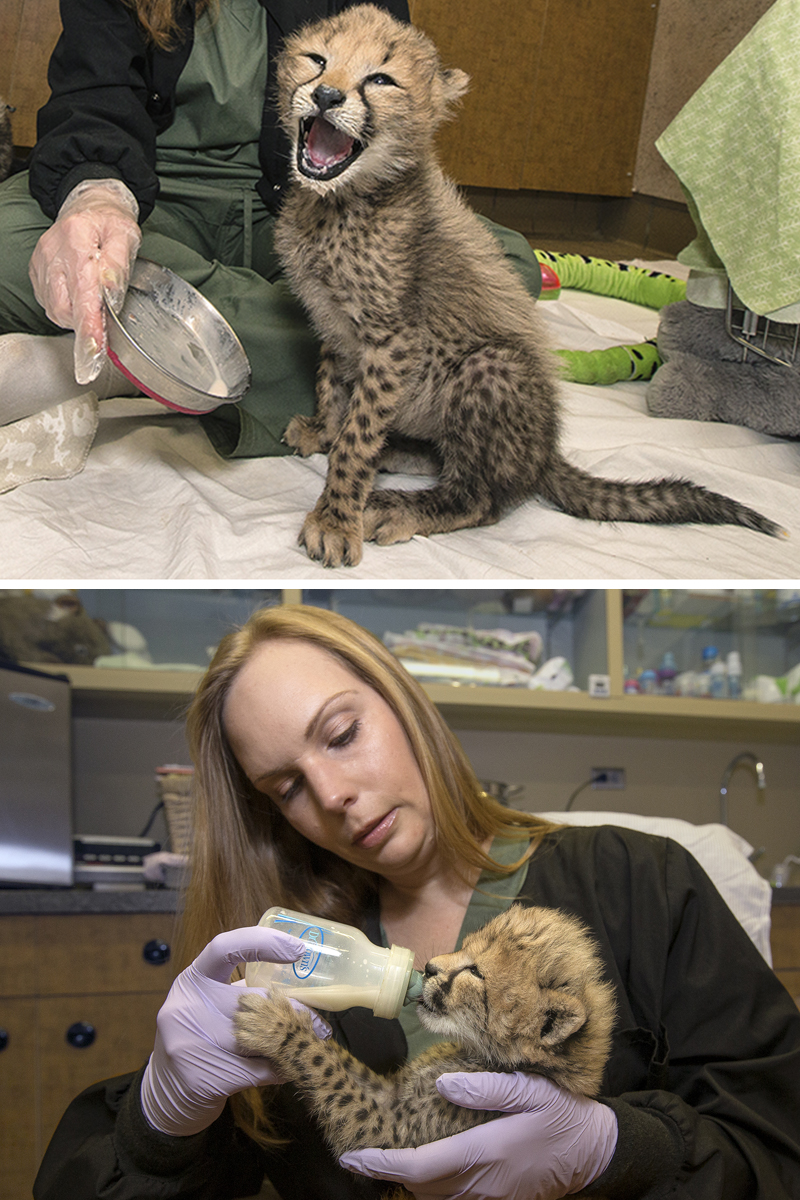
WHAT’S FOR DINNER?
Cheetah cubs Tombi-Jeanne and Ilangha were energetic eaters at the Ione and Paul Harter Animal Care Center nursery, quickly finishing their bottles, and scarfing down chopped meat mixed with formula.
At first, keepers called them “Purple” and “Yellow” for color splotches on their tails used to tell them apart. Their individual personalities quickly became evident. “Purple (Tombi-Jeanne) was the more polite of the two,” said Eileen Neff, a senior keeper. “But both practically got their bottles done in two seconds. And they both had sharp little teeth.” When they started eating solid food—a chopped meat/carnivore diet mixed with formula—Ilangha (Yellow) proved to be the more eager eater of the pair. “Yellow will scarf down the food. She loves to eat.”
NEVER A DULL MOMENT
It’s easy to see why so many Safari Park guests gathered at the window of the Animal Care Center nursery to watch the tiny cheetah sisters enjoy feedings and playtime. (Videography by Victor Schwanke)
Ilangha also proved to be an eager explorer, said Ian Chatfield, a keeper in the Animal Care Center nursery who Lissa calls the cheetah papa. “Yellow (Ilangha) is definitely more outgoing,” Ian said. “If there’s something new, she’s the one to give it a go—with no hesitation. Purple (Tombi-Jeanne) is more calculating: she’ll carefully check out what’s going on before she ever tries it.” For example, when the cubs were introduced to steps, “Yellow didn’t hesitate,” Ian said. “Purple needed a little encouragement.” Both enjoyed playing with a red rubber ball, grabbing it with both paws, and batting it around the nursery. The cubs also spent a lot of time wrestling, practicing “play-pouncing” attacks, and play-biting each other’s rear end. It’s all part of learning how to be cheetahs.
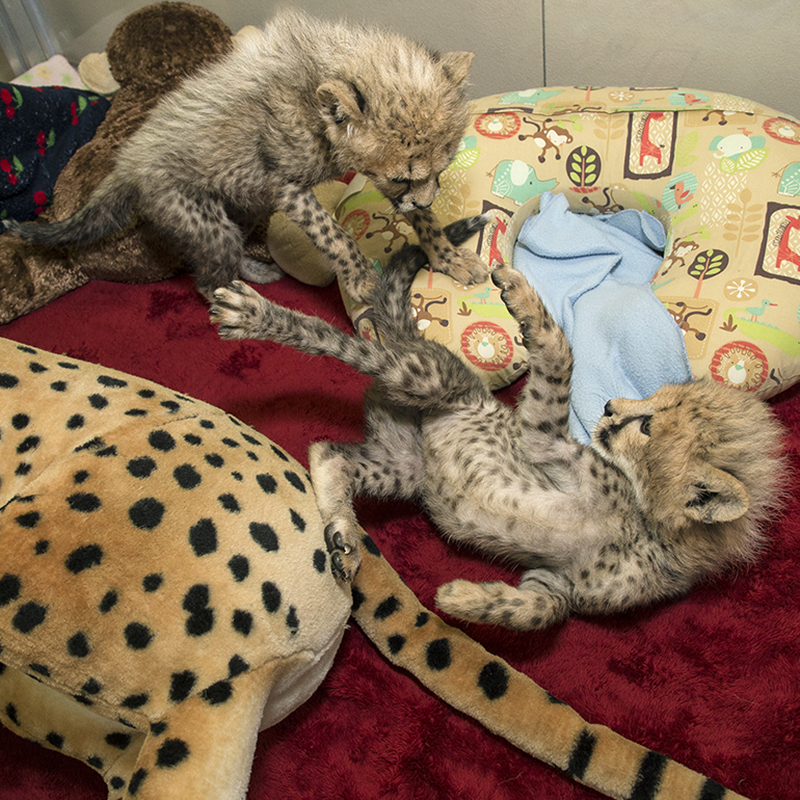
PLAYFUL PAIR
The many hours Tombi-Jeanne and Ilangha spend wrestling, stalking, pouncing, and chasing each other help them learn what it takes to become adult cheetahs.
Early training consisted of teaching the cubs the basics. “We start to work with polite behaviors when feeding, so they don’t climb all over us,” Lissa said. “We also start with crate training, showing that it’s a positive place, since as animal ambassadors, they will spend time being transported in their crates. We feed them in the crate and get them used to spending positive, relaxing time there.”
As animal ambassadors, the cheetahs will attract a lot of attention—and while learning about them, guests will also learn about the challenges that cheetahs face worldwide. Last December, a new study published in Proceedings of the National Academy of Sciences reported that only 7,100 cheetahs remain in their native habitat—nearly half the previous 1975 estimate of 14,000 cheetahs. The Safari Park is one of nine facilities participating in the Cheetah Breeding Center Coalition, and maintains an off-exhibit breeding center at the Park. The goal is to help build a sustainable population of cheetahs and prevent extinction of the world’s fastest land animal.
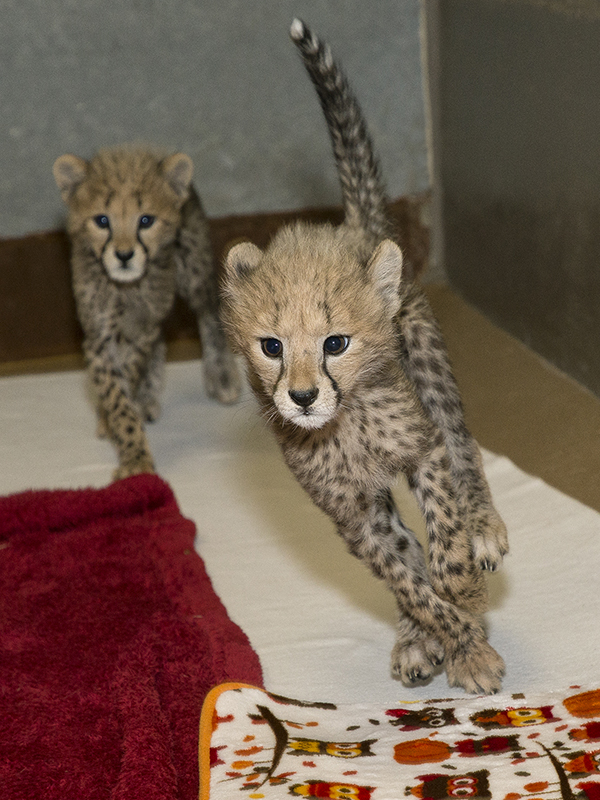
YOU’RE “IT”!
For two cheetah cubs, chasing each other comes naturally—and they put a lot of passion into those high-energy chases.
The cheetah cubs were weaned from the bottle in mid January, and then introduced to an outdoor exercise pen. Now, they have graduated to their new home at the Zoo, where they are in training to be animal ambassadors. When they are old enough, each sister will be matched with her own dog companion. “The sisters have been such a joy to work with,” Lissa said. “It’s been neat for them to have each other as young cubs, sleep next to each other, and play together as they developed. And it’s been a whole team effort to help them grow and get excited about their new surroundings.”

